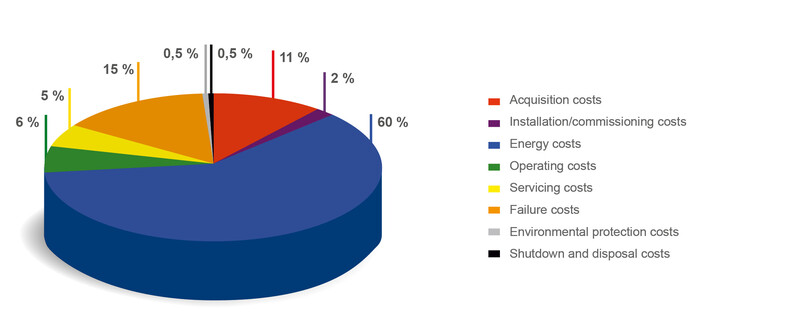Costs of the life cycle Analyse the cost structure intelligently
All costs should be included in the economic assessment of a product. It is not enough to consider only purchase and installation costs – as was usual until recently. All costs incurred during the life cycle of a system – the life-cycle-cost (LCC) – should be taken into account. This calculation is particularly important with pumps. Even when they have annual runtimes of over 8,000 hours, like swimming pool pumps, they have a long service life. The LCC gives a very good reflection of the overall costs.
Different systems have to be considered separately. In the centrifugal pump industry, a distinction has to be drawn between sewage and clean-water pumps. Where sewage pumps require high operational reliability in order to be operated to optimum effect with regard to LCC, this operating reliability can be assumed in the case of clean-water pumps, since they do not handle media that damage the pump hydraulics.
Calculate the life-cycle-costs of a pump
You can use our LCC calculator to calculate the life cycle costs at any time to create your own operating costs calculation. Follow the link to the LCC calculator.

| Cic |
Acquisition costs (purchasing price of the pump, piping) |
|
| Cin |
Installation/commissioning costs (installation, commissioning, training) |
|
| Ce |
Energy costs (electrical energy absorbed by the motor) |
|
| Co |
Operating costs (labour costs for system monitoring) |
|
| Cm |
Maintenance and repair costs (regular recurrent and expected repairs) |
|
| Cs |
Production failure costs (loss of production) |
|
| Cenv |
Environmental protection costs (contamination caused by the pumped medium) |
|
| Cd |
Shutdown costs (sales profit of the used pump) |

The following example calculation of the life cycle costs illustrates this aspect for three different pump sizes with equal nominal diameter:
| Required duty point: | Q = 160 m3/h, H = 7.5 m |
|---|---|
| Motor alternative 1 | |
| 4.0 kW without frequency converter | Efficiency: 60 % |
| Motor alternative 2 | |
| 5.5 kW without frequency converter | Efficiency: 86 % |
| Motor alternative 3 | |
| 5.5 kW with frequency converter | Efficiency: 86 % |
If the required duty point can be realised by two different pump sizes, the customer usually chooses the smaller and therefore cheaper one that simultaneously has a worse motor efficiency. This means that energy costs and finally LCC increase over a period of time (alternative 1 in the example above). Regarding alternative 2, savings resulting from lower energy costs due to the implementation of a more powerful motor can be distinguished. Alternative 3 shows furthermore the savings resulting from the implementation of a frequency converter. Also in this case the higher purchasing price amortizes with the resulting savings during operating time.
Calculate the life-cycle-costs of a pump
You can use our LCC calculator to calculate the life cycle costs at any time to create your own operating costs calculation. Follow the link to the LCC calculator.
to the LCC calculator
